Interview with
Anatolii Ivanovich Zuev
by Oleg Korytov and Konstantin Chirkin
Editors Igor Zhidov and Dmitri Sribnyi
Translation by Oleg Korytov
Special thanks to Svetlana Spiridonova
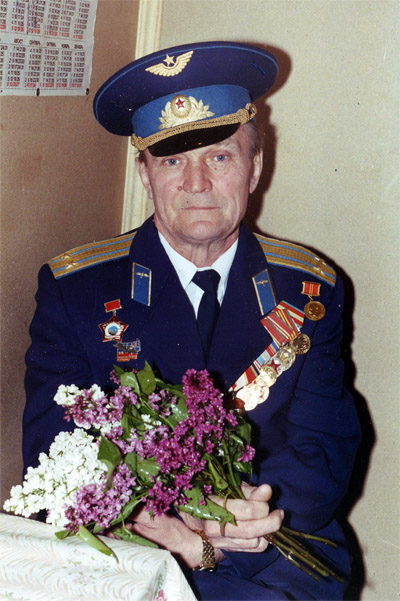
Lt. Colonel (ret.) A. Zuev
I’m Zuev Anatolii Ivanovich, colonel in
retirement. Former fighter pilot, was born on 17 November 1933 in my beloved
Leningrad.
My father was a peasant. Later he left village and worked at the factory
“Red Triangle”. Made it there to a position of a master. Mom also worked at
the same factory. They both came from the same village, but married here, in
Leningrad in 1932. In 1933 I was born. We lived at the Obvodnii canal
embankment – factory provided my dad with an apartment there…
— How your parents lived through the
Blockade?
I’ll tell you about Blockade...
In June 1941 we were in the village, at my granddads home. We were playing
on the street with my brother, who was 4 years younger than me, we came
home, and there were lots of people… everybody shouted:
— War!
Mom said to grandfather:
— I’m going to Leningrad.
My grandfather was old, he made it to 97 years old, told here:
— Tonya, don’t worry, we will kick their asses soon… Stay here.
Mom said:
— No, I’m to Leningrad.
And we went to Leningrad. Father wasn’t home; he was at the barracks by this
time. Those barracks were close to our home.
Mom was taken to dig trenches near Luga. Since there was no one she could
leave us with, we went along. I was 8 years old, my brother - 4. Mom dug
trenches; we helped her or played nearby. There I saw a dogfight for a first
time, two fighters fought. We noticed that one of them poured smoke and went
down. All boys ran there and yelled:
— Ura!
We were brought up that way, if shot down, it could be only German. We ran,
got to the wing, at this moment pilots head shook, so we decided that he was
alive. We had no idea how to open canopy. Adults came, opened canopy, pulled
pilot out. It was our pilot, senior lieutenant.
It must have been youngsters’ maximalism. But at the grave of this pilot I
swore that I will become pilot.

Cadets of Armavir school
— Were you bombed when you dug
trenches?
Of course, I still remember that we hid in
the trenches, and my mom covered her head with a spade. We all laughed about
it later…
I think in mid August we returned to the Leningrad. By 8 September a ring of
blockade was closed over Leningrad.
— Did you try to escape from the city?
No, we didn’t try. They wanted to evacuate
us without parents to Tikhvin child shelter. But mom came to the railway
station and took us back. We lived through all blockade here. I don’t want
to recall all the horrors, don’t ask…
— I heard that children were evacuated
without parental permition.
Never heard, No. Children were evacuated
only by parents’ permition. "Silently"? Never heard.
All blockade we lived in the city… We left it only at summer 1944 after
liberation of Brest, to his new place of service. My dad was wounded, he was
appointed to work at NKGB, and we came there.
— You mean NKVD?
No, NKGB. National commissariat of state
security. NKVD — internal affairs. I lived with my parents in Brest up till
1950. In 1950 I stole 400 rubles from them and fled to Odessa, to apply for
a place in flight school. Father didn’t want to let me go there…

Cadet Zuev on the wing of Yak-18
— Did you finish your high school?
In 1950 I graduated 7th grade and ran away
to Odessa. To Odessa special medium school. There I studied from 8th till
10th grade. After we finished 10th grade we were sent to military school. In
this Odessa school we received basis in aviation.
— How you found out about this school?
You didn’t run away just for luck?
Of course. A comrade came on vacation.
Nikolay Leontyev, if I remember correctly. He said:
— If you wish to fly — come to our
school.
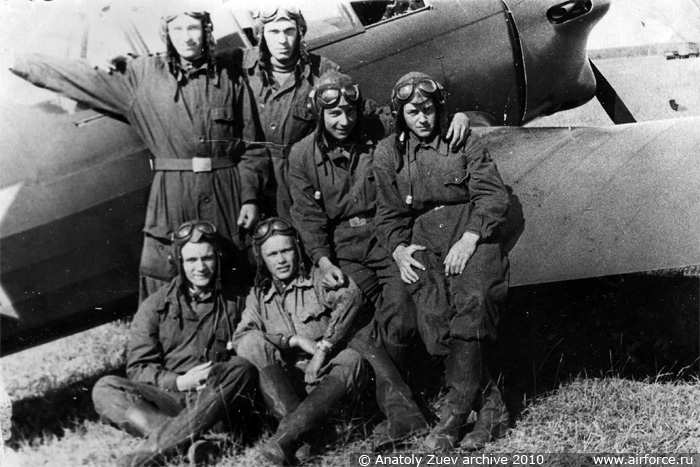
A group of cadets besides Yak-18
— You didn’t train in aero club before?
No, not in aero club, straight to this
school. I ran away from my parents… In all, I was lucky to meet good people.
I passed all exams with “excellent” marks. On medical commission everything
was fine, when a therapist, young women asks:
— What is your normal blood pressure, young man?
I replied:
— Doctor, I see this thing for the first time in my life and have no idea.
— Did you rest?
— Yes, I rested. I swam in the sea for a day long.
She smiled. Other one would have signed me off for high blood pressure.
— Sonny, go home, and I’ll be waiting for you tomorrow.
I came back on the next day. She said:
— Now your blood pressure is normal.
That’s how I passed medical commission… now it was time for mandatory
commission.
I played volleyball the next day. I was a sportsman, engaged in track and
field athletics. I was very thin. Somebody called me:
— Zuev, school chief waits for you!
«What could I have done?» I came in:
— Sit down, son.
I sat down.
— I see that you passed all exams, good boy. Medicine is granting you green
light. Wouldn’t your parents disagree?
I said:
— No, they do not disagree.
I still remember, how he smashed table with his fist:
— Get lost, bastard! He came here to become a pilot! His parents are
searching for him all over Soviet Union!
Just imagine my condition — all was lost. I begun crying, turned and walked.
If his cabinet would have been shorter, I would have walked away. As I took
door handle, he said:
— Stop! Come here. Why you are whining? Do you really want to fly?
— Yes, I want.
— Send a telegram to your parents that you are enlisted to the aviation
school.
I replied:
— I can’t I have no money left.
He gave me ten rubles:
— Take it. Return them later.
I let my parents know that I begun studying at this school.
At the second course about 15 boys were killed at the beach.
— And how did it happen?
A naval mine was washed out to the shore,
they begun fiddling with it… It blew… We were simply boys. Others were
crippled…
I graduated from 10th grade, went to Leningrad, where I finished Leningrad
aero club. Dad returned in 1953. From aero club we were sent to Kuznetsk,
that’s near Penza.
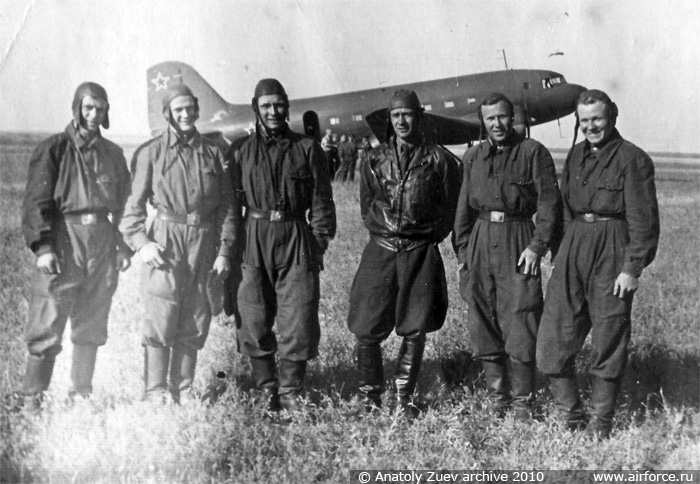
Before the training parachute jumps:
Shankin, Zuev, Averyanov, Instructor Askold Kozlov, Nikitushkin, -
— Where Leningrad aero club was
located?
Near Circus, at Sadovaya street. But we
didn’t fly there, we only received theoretic knowledge there… I made my
first flights on Yak-18 in Kuznetsk, where was our aero club flying
practice.
— Did you fly straight on Yak-18, or
you had U-2s?
We flew on Yak-18 with a tail wheel then.
Later it was redesigned for a nose wheel, so that it would be closer to
combat planes. I graduated from aero club and went to Armavir military
flying school. There after Yak-18 I flew Yak-11, then MiG-15 and MiG-15 Bis.
I finished school with a first class.
— What was your rank after graduating?
All graduates received a lieutenants rank.
— When you finished your studies?
I came from Leningrad in 1953. In 1955 I
graduated from AVVUL.
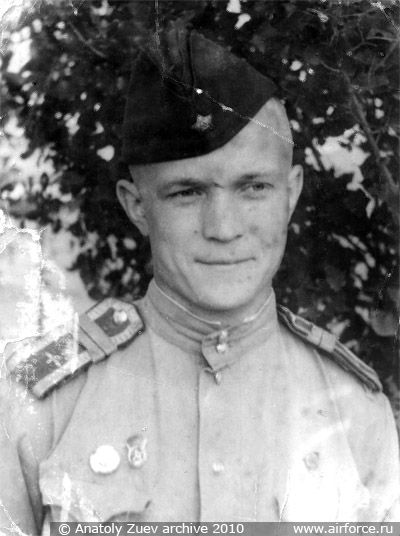
Junior sergeant Zuev
— Were there veterans of GPW or KW
among your teachers in AVVUL?
There were no participants of KW, but all
of them were veterans of GPW. Squadron commander Melnikov fought. My flight
commander, who taught us to fly Yak-18 and Yak-11 also fought.
— Stalin died in 1953…
Yes.
— What was your opinion about Stalin
and Communist party then and now?
Best. I believe he was greatest leader of
our country. Those days it was even more so. We stood honor guard near his
monument in our club. It was March…
— Were you armed?
No. Near his monument in Lenin’s room
guardsmen were changed through even periods of time. People were coming in.
Sad music was playing.
We were grateful to him for his expression about pilots: «Pilot — is a
concentrated will, character, readiness to risk. It is said that bravery can
capture towns. But knowledge is no less important».
I remember his saying for the rest of my life.
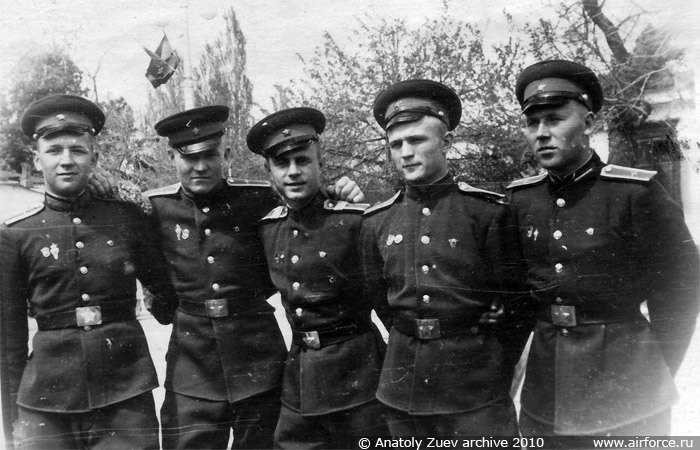
Graduates of 1955.
— You graduated in 1955, where you went
next?
Next… We had no idea when we were closing
in to our graduation. We were stationed near stanitsa Boronovskaya. We were
taken to Armavir to measure us, to sew uniforms. They were made individually
for each of us. Overcoat, trousers, everything. Three weeks later we came
for first try-out.
Starshina yells:
— Zuev!
— Me!
A naval jacket was brought out, black trousers, overcoat, white jacket… It
meant that I’ll go to naval aviation. We tried our uniforms…
State exams were going. Commission arrived, under command of Corps commander
HSU General Hlusovich. Hlusovich was a Belorussian.
Flying technique at first…
We were lined up. Our squadron stood, 45 cadets. Our instructors were also
there. Flight commander Vladimir Nikolaevich Kat’kalov ran to me, weaved his
fist at me, and said rudely:
— Grey, …damn you… you will fly with the general. Don’t shit on the
Cossacks!
«Grey» — it was my nickname. My hair were white.
I sat in the twin control airplane. We had to make 3 exercises: fly into the
zone with controller, make two flights in circles and one flight to the
shooting range for live ammo fire at the ground target.
— All at the same airplane?
Flight to the zone with controller on
MiG-15 UTI. Others on MiG-15.
I came to the zone:
— Permition to begin maneuvering?
— Go on, son, go on.
I flew, returned to base and landed. Taxied to the parking area, a see all
squadron looking at me. Everybody were standing there: cadets, instructors,
squadron commander Mikhail Ivanovich Kuznetsov is in the head of the line. I
waited for controller to leave cockpit, and walked towards him:
— Comrade General, I’m ready for your remarks.
He said:
— Let’s go.
He lead me to the line, and general sais to my commander:
— Squadron commander, if all your pilots fly like this one, you will have no
problems with passing state exams. His mark is “excellent”.
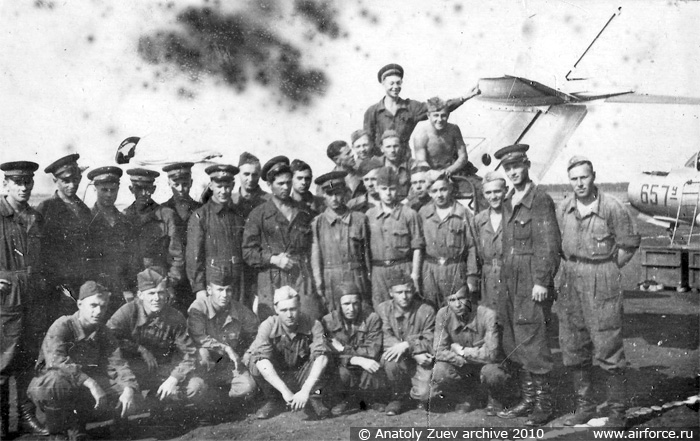
Cadets of Armavir school before graduation
in 1955
— What was meant by zone flight?
Take off. Go to a specific zone, 15 by 20
kilometers. Upon arrival report:
— Zone occupied.
And start your task: veer to the left, to the right. Dive, climb. Dive,
climb. Half roll, loop, half loop. Barrel roll. Then spiral descend,
approach and landing. That’s what was called a zone flight.
We also had to make a flight to the shooting range. 20 rounds were loaded. I
came to the shooting range, found target, «boom» at it… Landed, and saw
cadets running towards me:
— Grey, You got 16 hits!
Standard was 8 out of 20 — “excellent”, 5 — «good», 3 — “average”. If you
had less than 3 — «unsatisfactory». I got 16 hits.
Two box flights I also accomplished with «excellent». Landed. My instructor,
Alexandr Vasilyevich Kozlov came and said:
— Grey, do you see that airplane? Cadet Danilkin made a zone flight with
“average”, shooting range with «unsatisfactory». If he will accomplish box
flight poorly he will be expelled from the school. But he studied for 2
years. Get in that plane and fly with Danikins call sign 2 box flights.
I ran, got into the plane and flew with Danilkins call sign with a mark
“excellent”.
But Pavel Danilkin… I believe that I’m guilty in his death. He graduated and
perished on his first year of service… Not everybody can fly.
May be he wasn’t fit to fly. For two years he was trained, lots of kerosene
was spent on him, but he didn’t become a pilot. And perished…
I served at Baltic, when I was told that Pavel Danilkin crashed. Guys told
me:
— If you only refused…
I replied:
— How could I refuse?
— He would have flown himself, got a bad mark, wouldn’t become a pilot, but
would have stayed alive.
Bad fate…
Now we were getting ready to pass theory. Aerodynamics, airplane
construction, navigation…

Cadets playing domino at their spare time
— As far as I know, in our education
system it was preferred to teach airplane construction to the last rivet.
Was it really needed?
Sometimes yes. There could be cases when
it’s needed. Have you seen a movie “Baltic sky»? A pilot there got out of
the cockpit and asked a boy:
— Do you have a coin?
Something got stuck , he inserted coin and engine begun working. Pilot has
to know his airplane.
— Americans and Germans believed that
knowing technical part is a — that’s mechanics business...
Deep technical knowledge – of course. But
pilot has to know how it all works.
— But pilot in our armed forces was
trained like technician. Do you really needed all those knowledge?
To be honest — no. I never needed them.
You land — technician asks:
— Any complaints, comrade commander?
I say what I was not satisfied with, and go away. They begin to repair the
planes…
So, we were at our theoretic exams. Those, who passed all exams and flight
practice with “excellent” mark were graduated as first class — it meant that
they had a right to choose army or fleet to serve with.
I passed all exams, only service charters remained. I pulled the ticked –
everything was clear. I had a friend, Alik Kirsh, Lithuanian, good fellow. I
helped him with something. A colonel from north-Caucasus district was the
examiner, he noticed it:
— Comrade cadet, I’m reducing your mark by one.
I came out to answer, reported.
— Go, you have four.
I went out of the exam class, flight commander:
— Well, Grey?
I answered:
— Four.
— Oh, damn, why?!
Each commander wants to see his cadets with best marks. Captain Katkov went
to the examiner, came out and said:
— Go inside!
I went in.
— Fine, if you will answer me correctly, I’ll put “5”. There is a barrel of
water in the barracks, with a cup fastened to it by chain. How long this
chain should be?
Damn! I can’t recall this from the charters. I thought: Pilots could be no
less than 155 centimeters and higher than 190.
— Chain should be one meter twenty centimeters long.
— Fine, I’ll put 5 for bravery. But it should be no longer then 80
centimeters long.
That’s how I graduated with “first class”. My instructor said to me:
— if you want a sun tan, choose ChF. If you want to be away from your
homeland, choose TOF. If you want to become a pilot fast — you have to
choose BF.
So I wrote a rapport to Baltic fleet.
— Why “if you want to be a pilot” —
then Baltic?
Because Baltic has very capricious
weather, mists… Further on – continental type of climate… By the way, I
really became a “second class” pilot quite soon.
— Where you came?
To the Mamonovo town…
My identification card was issued, I got dressed in uniform. Ceremonial
graduation. HSU General-Major Geibo, chief of the school handed out our
shoulder boards; we adjusted them there and then, and load at the train. We
go to Armavir, then on the train to Sochi. There were seven naval officers
and four army pilots, who were going to Leningrad. We got drunk. Month of
vacation, then I started serving at the Baltic Fleet.
We arrived to Kaliningrad, to the stab. We were met there by fleet aviation
commander General-colonel Preobrazhenskii. There also were squadron
commanders…
We were taken to Mamonovo by bus. That’s how I begun serving at the combat
unit.
— I’ll return a little bit back. How
airplanes in your school were painted?
«Yak-11» was green, with blue belly. And
«Yak-18» too. «MiG-15» was just plain silver.
— Were there numbers on the planes?
Of course.
— 1, 2, 3, 4?
No. Numbers were long, like «12-52». May
be to confuse the enemy, that we have lots of them. On the left and right
side of the plane near the cabin. They are visible on the photos…
— To which regiment you were assigned?
To 412th. That’s former 4th Guards IAP.
— At which plane types?
«MiG-17».

A. Zuev in MiG-17 cockpit
— You graduated school at «MiG-15». Was
there any difference in piloting them?
No, just «MiG-17» was a bit longer.
My flight commander was a participant of GPW Gornichenko. He gathered us and
said:
— Who will get into airfield chief pre-accident log: landing short of “T”,
beyond it or some other thing, will study pilots instruction by word. I will
teach you, boys, to fight. But I have no idea how to take off or land
myself.
He was a good flight commander. He fought, shot down 8 enemy planes and was
shot down once himself.
That’s how my service at the navy begun.
— Who was regiment commander at that
time?
Regiment commander was Colonel Malakha
Vladimir Afanasyevich. Before that, during war regiment commander was
Golubev. Now he is a General, and lives in Leningrad. Golubev, Golubev,
forgot his name. Oh, Vasilii Fedorovich Golubev.
— No, he used to live in Novgorod, but
he died already.
Golubev used to be deputy army commander
in Siberia. We just arrived to Siberia and sat in the stab, he found out
that we came and met us. How did it happen, we flew «MiG-17» and suddenly
14th Detached Army PVO, sent in a representative, to choose pilots.
— Were you chosen on a free-will basis,
or “voluntarily by order”?
We were not asked. Somebody wanted,
somebody didn’t. He looked through the flight logs. Well, we were taken from
Mamonovo… We came to Tolmachevo in Siberia, where we flew along with civil
airliners from the same airfield. But after one of our fighters almost
landed on top of Tu-104…
— That’s all, — we were told, — boys, this crap should be over, we have to
remove the regiment from here.
— Did you kept flying MiG-17s?
Yes, we flew MiG-17. We were sent to
master new planes.
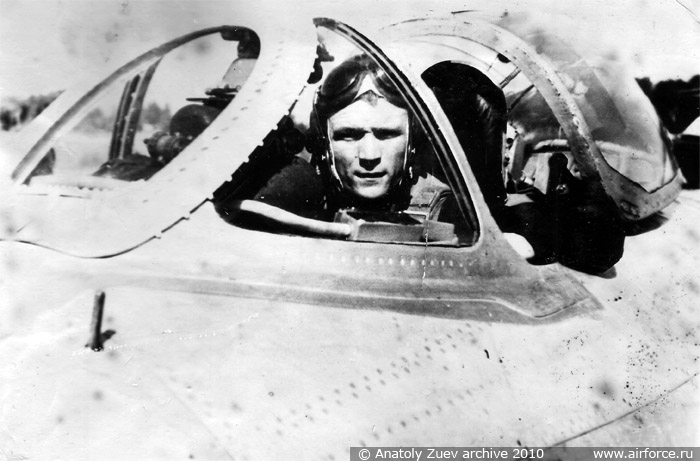
A. Zuev in MiG-17 cockpit
— Let’s return a bit back again. You
graduated from school at Mig-15 or MiG-15 Bis?
MiG-15 Bis.
— And you came to a regiment equipped
with MiG-17?
MiG-17.
— We talked to people who fought in
Korea, and later flew MiG-17, they told us that -17 was more “oak-like” then
-15.
Yes, because it was one meter longer.
Airplane was heavier and more inert… With the same VK-1 engine built by
Vladimir Klimov.
…I came to 412th regiment; we were introduced to our squadrons. Squadron was
organized like it was during war. Squadron commander, deputy, flight
commanders, political deputy, and chief of staff. He was not a pilot.
There were three flights and a command flight, three flight commanders, a
senior pilot.
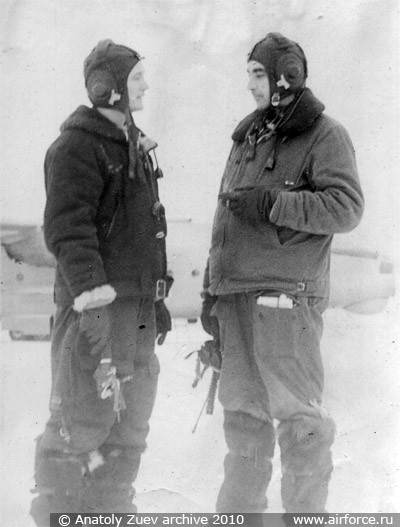
A. Zuev with pilot-instructor Rinat Abaev
— And political officer?
He was a pilot. Pretty bad one.
— What was your attitude towards
political officers?
I almost got called for it to the party
commission. I was a senior inspector-pilot of 14th PVO Army. We, 12
instructor-pilots had a separate table at the canteen.
Once I got late to the table, walk towards it, when Boris Shaifer, our Army
engineer asked:
— Anatolii Ivanovich, say to me honestly, should there be a political deputy
in the squadron?
— Of course he is needed — squadron without a political officer is like a
village without local fool.
Somebody reported… Gudkov, instructor from Army political department,
summoned me:
— Anatolii Ivanovich, what do you think of squadron political officer work?
I replied:
— Well, I think it is needed. 12 pilot, almost 30 technicians, 60 soldiers —
it’s almost a company. Zampolit should be in the squadron.
— Why you say in such bad words about them?
I said:
— Excuse me, comrade Lt. Colonel, but I saw a lot of them, beginning from
flight school. We had Captain Gus, who was running around with “combat
paper”, and did nothing else.
But I wasn’t punished.
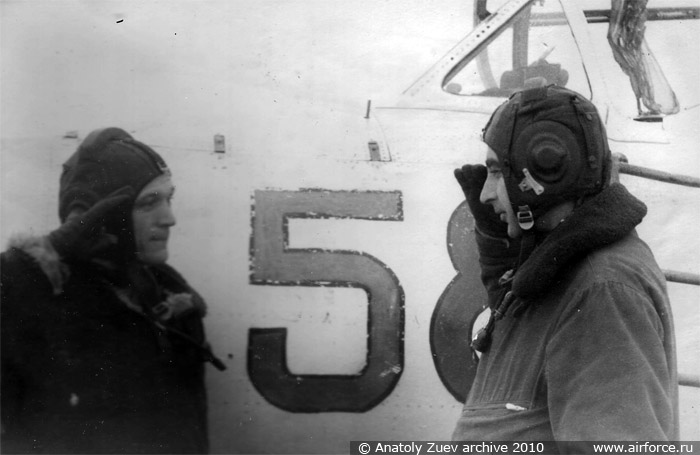
A. Zuev and R. Abaev
— How did you begun flying in the
regiment? You should have been tested for you flying technique?
Of course. I flew a zone mission with my
flight commander.
— And after that training must have
started? How it was organized?
From simple to difficult. First in simple
weather condition, then in complex, up to the minimal. In 1955 I graduated
from school, in 1960 I received a title «military pilot 1st class».
— What was your rank?
Captain. I received a Senior Lieutenant as
supposed one year after graduation.
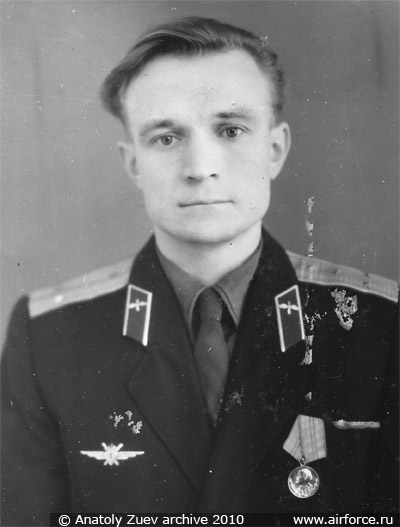
Captain Zuev after receiving “1st class
pilot” degree, 1960.
— Tell me, in Mamonovo, as far as I
know, situation was very complex, border was close and so on.
Last village was Branevo, 15 kilometers
from us. After that was border.
— Late 50s - early 60s was difficult
time — common reconnaissance flights from the other side… Did you fly real
intercepts?
Yes. I personally participated together
with flight commander. We were sitting in the guard house:
— Air!
We took off…
— Was an “Air” command always given to
Alert flight, independently, whether it was training or combat situation?
Test? No, alert-1, everybody in the
planes. I connected to commanding officer:
— Air.
Technician starts engine, I taxi to the runway, and we take off in pair. I
remember like now, that I was on guard with flight commander Adolf
Popovskii. Took off, course was given, gained 11 000 meters, noticed
inversion trail heading towards our territory. An American «B-47». They
tested our readiness. I said to commander:
— Do you see on the left?
— Yes, I see.
Flight commander reports:
— See the enemy, goes with such and such course. Arm weapons.
I armed weapons — one 37 mm and two 23 mm. Commander said to me:
— Move to the front!
I moved to the front, this «B-47» reached shore line, turned and went along
it. Near Klaipeda was another regiment, so I heard over radio that a pair
was raised from there which went to trail it further. We received an order
to return to base… There were flights like these.
— Were there real shooting cases?
There were no such cases.

Flight commander Zuev gives a debriefing.
849 IAP
— Did you have enough speed to catch
that B-47?
Of course. B-47 had about — 900 km\h. We
had 1200 km\h.
— For how long you could trail it?
Depended on amount of fuel. Sometimes our
fighters had to land at other airfields. There was such case in Palanga.
— Would you have obeyed an order to
fire if you had one?
Of course. Why not?
— Well, it wasn’t war time…
Not a war time, yes… Let me tell you a
story. It happened when I served in Kupino, Siberia. I sat in the guard
house.
Suddenly:
— Air!
I got into my plane, connected with control officer. Usually, if it was a
control flight, missiles were removed. But control ordered:
— With weapon.
Damn, with missiles!
— What type of missiles?
«RS-2US»… I took off, course straight towards Novosibirsk.
— You flew Su at that time?
Already Su-9. I was directed to Barnaul area. I approached. Aeroflot Tu-104.
I tried to connect with him with first button – there we always had unified
radio channel obligatory for all Soviet airplanes tuned in. I called his
bort number:
— Such number, answer me.
Silence.
— Such number, I order to answer!
Silence. They must have lost orientation, got lost and drifted to the south,
fell out of the corridor. It meant that plane became a trespasser. No one
even heard about terrorists then, but still it was a trespasser. I report:
— Trespasser does not answer.
As I recall, a navigation officer was Anatolii Gnusarev, good guy, he used
to be a pilot, when he was signed off flying duty he became navigation
officer. He said:
— Launch one at him, but quietly.
I turned away, maneuvered into position and fired missile in front of him.
It flew before their cockpit… How it yawed! I called them:
— Next one will be at you, follow me.
I lead him to our airfield:
— Do you see a runway?
— I see it.
— Land.
Tushka landed, I landed after it. I came to them, all crew was lined up near
the plane, shaking, and captain was pale. I asked him:
— Listen, dear friend, why are we sitting here all together?
— Commander, we already regained orientation… We got lost…
They claimed that some navigation device stopped working. I told them:
— If I wouldn’t fire a missile at you, everything would have gone quietly.
Now I have to write a rapport to the General staff where I expended a
missile.
Pilot said:
— That’s it, I’m going to lose license now.
That crew was forbidden to fly. While we waited for a new crew, we took them
to our canteen, gave them tea. Then they left.
— Was that Tu with passengers?
It was full of passengers. It was August
or September.
— Did passengers know about this
situation?
They didn’t understand a thing. Plane
landed, taxied to the parking, they got out, loaded on buses and were sent
somewhere. We called to the Army stab, they – to Moscow, from there a reply
came:
— Allow flying on.
So they flew to their destination.
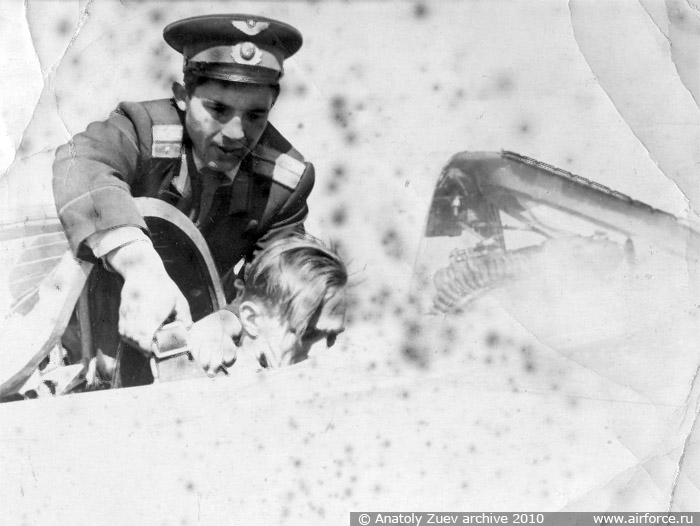
Airplane technician Bychik helps A. Zuev to
prepare for take off. 849 IAP
— Once again let’s return back. Were
there training dogfights in Mamonovo?
Of course. One-on-one at first, then
two-on-two, then flight-on-flight, squadron-on-squadron.
— You flew against the same type of
airplanes?
Yes.
— You all flew MiG-17 or were there
some kind of modifications?
In Siberia at Kanny regiment there was
MiG-17 PF.
— Did you fly them?
No, I never flew PF.
— Did you fly radar equipped MiG-17?
There was no radar, only plain collimator
gun sight.
— Were there pylons for use with bombs
or missiles on MiG-17?
No, only fuel tanks.
— That is, you were not trained to work
against ground target?
What do you mean? Bombs? No, we were not
trained to use them. But I had 200 rounds for cannons…
— In 1960 you were transferred to PVO,
so you should have changed uniform. Naval aviation had black ones, while PVO
had green.
Of course. I was in guard house, when
regiment commander lt. Colonel Vladimir Nikolaevich Yakovlev came in. I
reported:
— Comrade Colonel, alert flight commander Captain Zuev.
— Where is your hat?
I said:
— Here.
I had a navy style hat, as I didn’t receive an Army uniform yet. At flight
days I was dressed in flight suit and leather jacket. And I didn’t go to the
line-ups…
He took my hat, tore and threw it away:
— Don’t even appear here in this uniform.
That’s how I changed to "infantry" uniform.
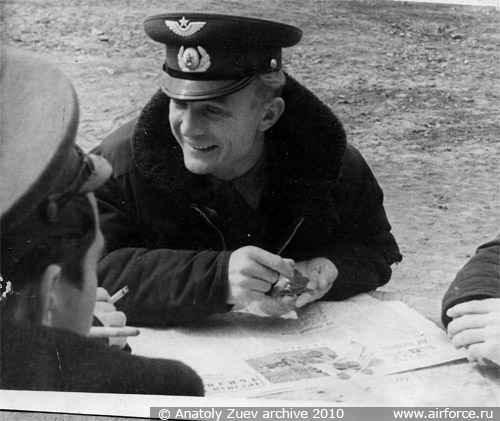
Let’s club together… for a celebration
— This uniform was standard, or it was
also sawn specially for you?
No, sawn. By measures. How an officer may
walk, looking like dressed in a flour bag or being unable to fasten his
belt…
— When you came to 14th army, what kind
of airplanes were there?
We were tested for flight technique at
MiG-17 straight away, even though we didn’t have our flight logs with us –
they were sent via Top Secret mail. Squadron commander Boris Ivanovich
Staroverov, now lives in Moscow, somehow he found out my nickname — «Grey»:
— Grey, Let’s fly together in a dual-control plane, and see how you handle
it.
3-4 flights in a dual-control, and we went to Savasleika to master T-3.
Later it was renamed Su-9. First supersonic interceptor-fighter. For two
month we studied this plane, but only in theory, passed exams…
— What was included in theory?
Aerodynamics, knowledge of airplane
construction. Aim sight RP-9U, if I remember correctly.
— There were a lot of complaints about
our early aim sights, up until ones installed on MiG-23 and Su-15, that they
were well used against targets at the same altitude or higher, but they were
blind against ground.
Su-9 worked against low flying targets
well. Armament had a range of 20 kilometers. Press a button, lock on, and
they off… As soon as target is within effective range you launch the
missiles…
We learned to fly Su-9 in combat unit already. As there was no dual-control
Su-9, we trained like this: You sat in the cockpit, the nose was lifted,
squadron commander said:
— Look — this is take off position… Raise a nose a bit more. Now – landing
position. Remember!
— What, simply raised the nose?
On jacks. We had to remember position of
PVD (air pressure intake for measuring speed) tube regarding horizon.
— When did it happened?
In 1960. In March we arrived to
Novosibirsk, for a month we flew, and went to Savasleika. When we passed
exams, returned to main base. To that same 849th regiment.
— Did enemy reconnaissance planes fly
over you?
Not airplanes. Balloons that they launched
reached us. For shooting down 11 or 12 balloons I was awarded with an Order
Honor Sign, and for shooting down 16 balloons I was awarded with Order of
Combat Red Banner.
— How did you shot them?
Flying the Su-9. MiG-17 couldn’t catch
them.
— Which altitude did they flew at?
Starting from 20 000 meters. They were
launched from Sweden, flew over our territory and landed somewhere in Far
East.

In Su-9 cockpit
— The size of the box was half a meter?
Yes, and they had lots of film in them.
With excellent quality film.
— How did you found out about its
quality? You haven’t caught them?
I’ll tell you. Boris Staroverov flew in a
MiG-15 UTI, when this balloon was shot down. They hooked it, and dragged it
into rear cabin. Their luck that they didn’t try to open it, otherwise it
would have blown up. When they landed, our specialists opened the box,
disarmed traps and got this film out. Very good one…
Actually, if they descended below 3 000 meters, they simply blew up.
(Editor: – No such episode was ever
mentioned in historical literature or interviews)
— How did you shot those balloons down,
by cannons or missiles?
Only with cannon. In three or four passes.
(Editor: - not clear moment, as A.Z.
mention below that there were no cannons on Su-9. On the other hand
description matches well downings of balloons by other pilots words in
MiG-17s)
— How you located these balloons?
Container was visible by radar.
— At about this time Powers was shot
down. Were you told about it?…
He was shot down in 1960. SA crews got
him, fighters couldn’t reach him. He went at 22 000 meters, our fighters
couldn’t get higher then 20 000 meters.
Powers was smart, he understood that he had possibility to eject. If he
would have only tried, the plane would have blown up – there was high
explosive charge under his seat…
— By the way, what is your opinion
about safety systems on soviet airplanes?
Ejection seat excellent. I had to eject
from Su-9 on 6 September 1961. (Editor: - According to data provided by
PPV (refer to our
forum), Zuev bailed out in 1962)
— What was the reason?
Was it in Novosibirsk area. I was on final
approach… Landing gear down, left and right lamps were green, nose one
black. Front leg didn’t extend. But what if indication bulb was bad? I
pressed a button and report to flight chief:
— Nose leg didn’t get out.
Flight chief answered:
— Fly over the airfield, we will switch searchlight on and look, whether leg
is down or not.
Fine, I descended, flew along runway… They said:
— No leg visible. You shouldn’t land.
I said:
— I will try to land.
If there is no front leg, you have to hold airplane nose up as long as
possible, because then it will drop the nose down, if the speed will be not
too big, I could have preserved the plane.
But flight chief has no possibility to risk my life, he said:
— Move away and eject.
By this time I flew so long, that there was no kerosene in the tanks. I flew
away from the airfield for 20 kilometers, when my engine “psh-sh-sh”,
switched off. I reported:
— Engine stalled.
— Eject.
I ejected… Then I was pretty slim, parachute was not fit right. It opened, I
was hit by the belt system at the chin so hard that my teeth clamped. At the
airfield three searchlights were positioned in a cone. While landing I
forgot that wind was 15-20 meters per second, so I was hit pretty badly. I
unfastened parachute belts, sat and waited. Then I decided, that if I see
the searchlights there is no need to wait, collected the parachute, and
marched towards those searchlights. Then I recalled that there was more than
twenty kilometers to walk. I walked out to the road dragging parachute
behind me, one car went by, another one… then a car stopped in front of me,
boys got out.
— Alive?
— Alive.
They kissed me on the cheeks. We came to the stab, regiment commander:
— So, what happened, how? Go on, spill it out.
Political deputy said:
— Commander, leave it till tomorrow, let’s go to my place.
Deputy commander Yesikov Valerii, very good commissar. Now he lives in
Kharkov. He was a flying commissar, and was signed off flying duty due to
age.
We came to his place, one glass of vodka, another one… They both are already
“full”, while I didn’t even feel that I drank a bit – that’s the result of
stress. I said:
— Well, I’ll go home.
My wife was told that I was alive and was drinking at political officers’
house.
I came home and went to bed straight away. On the next day a commission
came, they found wrecks…
Regiment commander said:
— You should go to recreation facility in Yeltsovka, near Novosibirsk.
I passed medical commission, they didn’t found any traumas, so I was allowed
to fly further on.

Squadron commander of 849 IAP V. Yesin is
controlling flights
— What is your opinion about Su-9?
We used to say: «it’s more frightening
then a tiger». At first there was no twin control airplane. You trained in a
real combat ready fighter, but there was nobody to show your mistakes. We
had to understand it by our intuition. Su-9U with rear cabin appeared only
three years later.
— But there were few pilots that flew
Su-9...
Very few. Our 849th regiment was the first
to train on these airplanes. It hadn’t completely fulfilled army trials yet,
but minister of defense ordered:
— Train them.
And our regiment was first to train.
(Editor: - According to data provided
by PPV, 849 was not the first among combat regiments to train on T-3 (Su-9).
By 1960 other regiments all along the country were flying Su-9s, but
airfield Tolmachevo was used as a basic field for training pilots from 148
TsBP at summer 1959. This choice was made because it was closest airfield to
Novosibirsk aviation plant, where Su-9s were built)
— Were there catastrophes?
Of course! Six pilots were killed and two
ejected. That’s only during 1960. Airplane had a lot of teething troubles.
(Editor: - According to data provided
by PPV, flight accident statistics for 1960 was a bit different - 4
catastrophes and 6 flight accidents. Airplane and engine suffered from
multiple teething troubles. Situation in 1961-64 worsened, with up to 38
accidents per year! Only at the second half of 1960s airplane became safe to
fly…)
— Could you name pluses and minuses of
this airplane?
Most noticeable plus was that we had
nothing like that before — top speed was 2 380 km/h. Minus — too high
landing speed — 360–380 km/h. you had to keep airplane like this on landing.
— Crows landing?
Yes. Land, put nose down, extend brake
parachute, but if speed will be too high it will be ripped off, and then
apply emergency brakes. But when you do so, tires will be destroyed, their
pieces fly straight at the wings, at the fuel tanks…
— Fuel tanks had no sealant?
Wing ones not. All others, around engine
were protected… With full load I had 3 680 kg of kerosene.
— How long could you fly with that
amount of fuel?
Depends on regime. If from takeoff till
landing on afterburner — 15–16 minutes. If in cruise mode — 50 minutes.
Maximum 1h 20m.
— At which altitude?
Speed — 600–800. At an altitude 10–11 000
meters.
— It is known that there was a problem
with airfield network then…
Our airfield was Kupino, 280 km — Omsk
airfield, 360 km — Novosibirsk, from Novosibirsk to Kansk — 700 km. That’s
our Army’s airbases.
— But if an airplane was lost, pilot
ejected 400 kilometers away from the base, were there problems with
survivability?
No. One of our pilots ejected at winter,
but he was quickly found. Parachute was caught by the tree branches, he was
located and saved. Frosts were severe, but everything was fine…
— What was included into NZ?
Everything needed: Chocolate, medicine,
cookies, what else, canned food. I don’t remember exactly now.
— Did you fly with weapons?
With PM pistol.
— If you would suddenly like to defect
abroad, could you have done it?
Belenko did it.
I can tell you the story about this Belenko. Commander summoned all
inspectors-pilots. There were 9 inspectors in the army. I overlooked two
regiments: Kupino and Kansk, 712 and 849, I was responsible for their
training…
— Well comrades’ pilots, what do you think… You know well pilots who… I
don’t know what to start from. — He sais — Commander of 11th Army Maltsev
called, and informed me that our pilot flew to Japan. Do you know your
pilots well? What he think about… But you should…
Belenko prepared long before. His father broke away from his family and
lived in Norilsk. Belenko visited him on vacation, and he was talked by
Americans into fleeing there. He returned right when they begun training on
the newest airplane MiG-25. He must have been a good pilot. I wouldn’t dare,
for example, to run away on fourth or fifth flight.
When investigation begun, Commander asked us:
— Is any of the pilots in friendship with special department chief?
When I served in the regiment I didn’t even knew him. He rarely visited us.
— This Belenko, — he said, — made friends with special department chief.
I often say, «Luck comes to fools and drunkards». Belenko made four flights,
on the fifth something broke in his airplane. Flights chief:
— Get in the spare plane, it’s there fully fueled.
Belenko took off, gained 10 000 meters, moved 300 km away from the airfield,
rapidly descended to 100 meters. Radars lost his mark, at low altitude he
crossed shoreline unnoticed and went straight to Japan. Airfield there was a
bit short, so he overrun and slightly damaged the plane. Japanese were
running towards hem, he pulled out his pistol and shouted:
— Don’t come closer! Find a translator.
They found one. He said:
— I came to Japan. This is a top secret airplane MiG-25.
He met with American agent. They loaded him into a transport airplane and
brought to Gerald Ford — US president. At those times MiG-25 was the best
plane…
Oh, forgot: Commander said:
— A commission from Moscow came and begun testing pilots. No one knows
anything, like if they are dumb. Go to the regiments check the knowledge of
the airplanes.
I said:
— That’s to be sure, if our pilots ever gets caught by the enemy they could
tell all they know?
He shouted at me:
— Stop laughing! Pilots must know what they are flying on.
I said:
— It’s good he couldn’t say anything.
Americans examined MiG thoroughly, and in about half a year or a year they
launched F-15, copied from our MiG-25. That’s the result of Belenko’s
treason. I’m not sure, I believe he got killed or got into “automobile
accident”…
(Editor: - Rumors of the death of
Belenko were a bluff. Belenko is alive and still residing in the United
States. Regarding the F-15, it is quite possible that the design of the
MiG-25 has had some influence on F-15 design, but the first flight of the
F-15 made in 1972 - four years before the Belenko escape)
— Let’s return a bit back. You trained
on Su-9. Did you fly them long?
Till the last moment. Up to 3 September
1976. I rose to a position of Deputy Regiment commander on Su-9.
— Training continued: did you have
training flights, fights?
There were no training fights for
interceptors.
— What was the difference in front
aviation and PVO in training?
Almost the same. A pilot is trained for
operation in all weather, and allowed for alert duties.
— Could a PVO pilot participate in
dogfights?
Could. But our regiment carried four
missiles only.
— And cannons?
Su-9 had no internal cannons. Four
missiles RS-2US. Then missile with infra red homing was made.
RS-2US was radar homing missile, it homed upon fixed ray. Infrared homing
missile locked on by itself. When you see PR on aim sight — launch
permitted. You launch, make sure it’s gone, and now you may turn away.
— While with Rs-2US you launched and
have to keep target in sight?
Yes.
— What if target starts maneuvering?
Missile would still follow it.
— What if target leaves sight by sharp
maneuver?
What kind of a pilot are you, if it evaded
you? When a missile was launched it tracked target even when it made a 9G
maneuver. Main thing was to keep it lightened by radar.
— When Korean Boeing was shot down…
Regiment commander was not too bright…
— Explain please.
There was no need to shoot it down. Pilot
was right – he obeyed an order. It was a regiment commander problem, from
the start he must have raised a pair of fighters on intercept.
— Wasn’t there a pair?
There was no pair there. When I was in
hospital bomber pilots from their neighboring 195th regiment told me exactly
what happened…
They should have placed him in pincers. So that they would have a choice of
either ramming our airplane or follow their lead.
If fighters would have done this, there would be no international scandal.
It was needed to land them, not shoot them down.
— There was a similar case with a
Boeing of this same airline near Murmansk?
Yes, there was such case. Our boys brought
it down with Su-7B. It also had pylons for bombs.
(Editor: - Interception was executed by
Su-15TM from Kem airfield. See
here for details)

— When idea for redirecting fighters to
fighter-bomber role, how pilots thought about it?
Fighter-bomber on which Kadomtsev,
Commander of PVO Aviation, perished was MiG-25. Not an RB version. No, plain
MiG-25. It could carry bombs from the start.
— As I’ve been told, there was a
special type of bomb developed FAB-500TS for MiG-25.
Possibly. But I never flew MiG-25…
— But I’ll return to my question, pure
interceptor MiG-25, which role is to catch target without maneuvers and
launch missiles at it, was loaded with bombs… It was used in this role by
Iraq…
Yes, yes, yes. Their pilots trained at our
bases.
— But practice showed that they had
problems with hitting a target with an area of over 20 hectares. So the
question arises – was it really needed?
May be not. But it was a supreme
commanders choice…
(Editor: - The result of MiG-25RB
deployment during the Iran-Irak war was very much depended on the
preparation of the equipment before the flight. In a case when the system
tuneup was performed by Soviet specialists, the bomb attacks were much more
effective, than in a case when it was done by local personal. See more
details here)
— You graduated from flight school
approximately when mass reduction of aviation begun.
In our regiment only old pilots suffered
from this. It all begun in 1960. I graduated in 1954, and by this time I was
a pilot. But we were not touched. Merchants from Siberia came and we were
transferred to this Detached Novosibirsk 14th PVO Army.
— Thus, this reduction had positive
effect on your career? Old men were removed, higher command posts were
freed.
On one hand yes. But regiment from
Mamonovo, former 4th Guards regiment was disbanded altogether.
— We talked to GPW and KW veterans, and
they say that if war broke out at this time, our country would be completely
defenseless from the sky.
Absolutely right. When Khrushchev was
removed, this was one of the points of accusation. He was the main
destructor of the army.
— What was done to the planes, when
regiment was disbanded?
They were cut. MiG-15, MiG-17 were already
obsolete.
— Let’s return to your career. 1966…
Before 1966 you still flew Su-9? Were there other types of airplanes?
MiG-15, Su-9U, dual control, I was alone
in the regiment who mastered it.
— Was it different in flying qualities
from standard Su-9?
Not really, it was only a bit longer. To
make place for second cabin. Training pilot sat in front, while instructor
in the second cabin.
— At which rank you were then?
Major, Squadron commander.
— When you became a flight technique
inspector?
It was in 1971. A PVO Army commander
approached me, I was deputy regiment commander of 849 IAP then. I met him at
the airfield, when regiment commander was absent. He asked me:
— Would you like to be an inspector in the Army?
I replied:
— Comrade Commander, I’m a fighter pilot, and never rejected any
propositions I received. I’m ready to serve Motherland where and how it
finds best.
— Get ready, you will be transferred to inspector position. Senior
inspector.
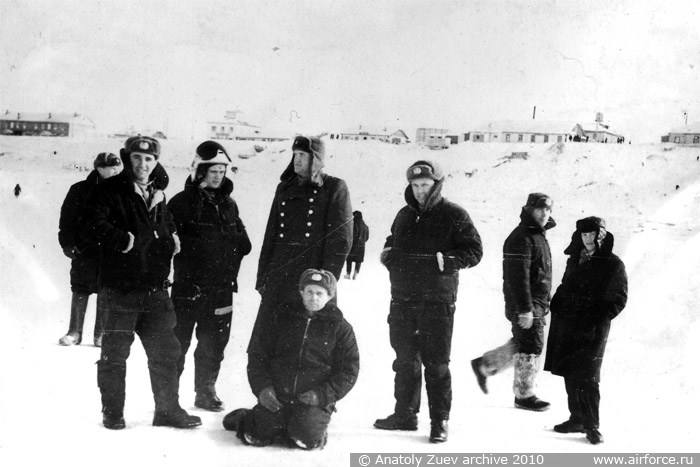
Khatanga airfield. First in a history
supersonic jets landing on a river ice.
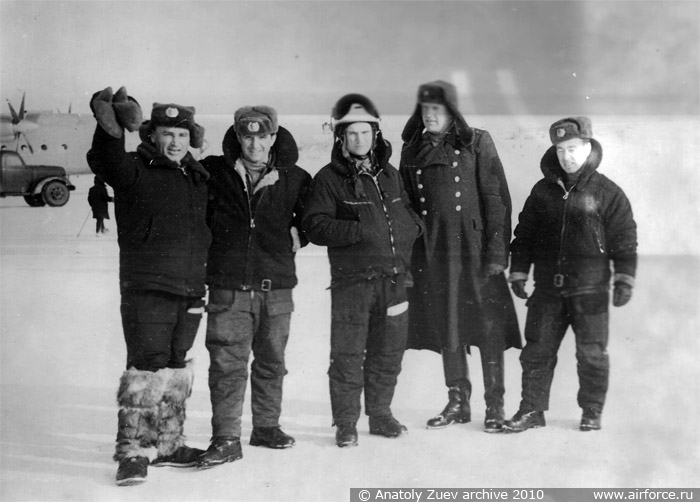
— You said that you kept flying Su-9
till 1966.
Why till 1966? Until 1976. In 1976 I went
to inspect some regiment, and to receive extra flights, as I lacked a few to
confirm my class.
But on 3 September 1976 I had to eject, and spent half a year in a hospital.
— Did you get ejection trauma?
Everything was fine, but I was evacuated
by helicopter crew. They located me, lighted by searchlight, attached a hook
to my flight jacket and began lifting me to the helicopter… Vladimir
Plotnikov, this Mi-2 pilot told me later:
— We dropped you from an altitude of 15-20 meters.
When I fell, I got a compression fracture of the spine. I was brought to the
Kupino airfield, from there on a “bee” to Novosibirsk hospital. When I came
to my senses, I was plastered from neck to pelvis and right leg on
extension.
— That is, you ejected twice?
Yes, twice. That’s where my flight career
ended.
— So you flew one and the same type of
aircraft for 16 years?
Yes.
— How did your regiment receive new
airplanes?
At first we flew MiG-17, then Su-9. 16
years on Su-9.
— How Su-9 was modernized?
New aiming device was used, more powerful
missiles... That’s all.
— After airplanes were written off as
crashed or used up, did you receive new planes?
Yes, of course. We had extra airplanes.
There were 40 or 42 pilots in the regiment and over 50 airplanes.
— What was your attitude towards ground
crew?
Very friendly. Technician is everything.
You get into the cockpit, he closed it, removed a ladder, switched engine
on…
— Was it difficult to repair Su-9?
It was, especially at winter. You could do
nothing in mittens, so they had to take them off… We flew till -35 degrees
C, it was considered as too dangerous to fly at lower temperatures…
— Did you study in the Air Force
Academy?
No, I did not. My commander did not allow
me. I wrote a repport that I want to study, but he said to me:
— Grey, don’t even think. I’ll send that fool who can’t fly to the Academy.
You are excellent pilot. Fly one or two years more, then you will apply.
I said:
— I will be over 34 then, and I will not be allowed to study.
That’s how I stayed without Academy. But I graduated from Regiment
Commanders Courses in Savasleyka. They were equal to Academy education. I
have a diploma.
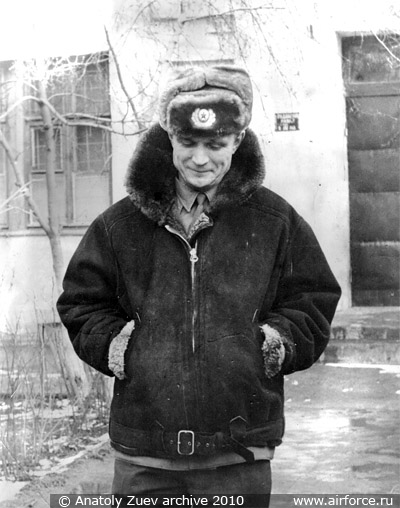
— Did you graduated from Courses in
1965, was a Major, and still remained a squadron commander?
Yes, Squadron commander. I was a deputy
regiment commander for six or seven month only. Then I became an inspector.
— What were your duties as inspector?
I had to look after two regiments. I was
responsible for pilots training.
— Didn’t it mean that you had to fly
with each and every pilot?
No. I came to Kansk, called regiment
commander:
— When you scheduled flights?
— Day after tomorrow.
I said:
— Plan control flights for you, your deputy, squadron commander and one
ordinary pilot.
— But regiment commander would pick best pilot.
Of course. But if his “best” can’t fly, how the rest will fly?
— What else inspector was
responsible for?
Confirming class. Regiment commander
called:
— Anatolii Ivanovich, we prepared four pilots for first class.
My task was to check them. They had to fly for combat use and land at
minimum weather – V2 X H200. We had to wait for complex weather.
— In 1976 you ejected and spent half a
year in hospital, right?
Yes. September was not the best month for
me… Three month on extension, one month in wheel chair, then trained to
walk. I came to the Army, reported and asked for retirement.
I was asked to wait for two years – pension was allowed for Lt. Colonel from
the age of 45, while I was 43.
Finally I asked for retirement, because there was no sense in waiting for
Colonel – pension for Lt. Colonel and Colonel was the same – 200 rubles.
Higher pensions were given to Generals, but there was no chance for me to
get a rank of general. That’s how I retired. I came here, to my father’s
home near Leningrad.
At first I worked as a teacher of aerodynamics in Pulkovo. I went to work at
Monday and returned at Friday. Wife said:
— You have to quit this work, it’s killing you. You have a decent pension.
I said:
— Well, I’ll do so.
But I was called to local Party committee, where I was suggested a position
of cemetery flower marked director.
I agreed, and keep working till these days.
Appendix: Su-9 crash, 1961